You’ve nurtured the lead, closed the sale, and are ready to watch the revenue roll in. It sounds like your work is done, but customer onboarding is the next make-or-break stage of the customer lifecycle. Poor onboarding can repel customers from the outset, but an upbeat start will convert product strangers into loyal customers who will spread the word about your brand.
This guide covers the best customer onboarding practices and key metrics to ensure you’re stellar at welcoming new users. We’ll also introduce monday sales CRM as a platform to oversee the entire onboarding cycle.
What is customer onboarding?
Customer onboarding is a proactive process that guides new users to explore your product or service, so they quickly get up to speed with the value it will provide them. This customer education journey begins immediately after customers buy or register for your offering, up until they perceive they are using the product or service successfully. The process should be fast, efficient, and frictionless, yet in some industries, McKinsey reports that onboarding corporate clients takes up to 100 days.
Andrew Allfrey, Founder of Huzzah, a post-purchase agency, explains the importance of customer onboarding,
“When a customer chooses your brand, they are not just buying a product but also an experience. The onboarding process is crucial, as it sets the tone for the rest of the customer journey. From providing clear product instructions and demonstrating usage scenarios to anticipating common queries with FAQs—these details matter.”
Why is a customer onboarding strategy important?
Precursive’s Customer Onboarding Benchmark report highlights that 74% of enterprise organizations have a dedicated customer onboarding team, and 82% rate their onboarding approach as a key driver of value. In contrast, only 13% of early-stage organizations have an onboarding solution and rely on spreadsheets to manage the new customer experience.
But developing a comprehensive customer onboarding strategy is beneficial for any size or type of business for the following reasons:
1. It creates a positive first impression
Management consultant Phil Woodbridge describes the primacy effect, a cognitive bias where an individual tends to give more weight to their initial impression rather than information received later.
“First impressions count significantly for a business when onboarding a new customer because they shape the customer’s initial perception and opinion about the company. Human beings are wired to make quick judgments based on limited information, and these judgments tend to be relatively sticky even in the face of contradictory evidence later on.”
2. It develops brand ambassadors
Invest in your customer strategy from the start to increase the probability of your new customers providing positive third-party reviews and word-of-mouth marketing on your behalf. People are inclined to believe content shared by “normal people” rather than brands, so it’s never too early to begin building your loyal fanbase.
3. It enables you to gather product feedback and pain points
Working closely with new customers as they explore your product or service for the first time enables you to walk in their shoes and learn more about their pain points. For example, if software customers find a menu navigation clunky or expect a feature to work differently, you can inform your product team to influence future development.
4, It provides upselling opportunities
Early customer conversations provide opportunities to promote other products, services, or upgrades in your range. A software company’s customer success team might discover that advanced reporting is important to their new user. They can offer a limited trial of an advanced plan with this additional functionality and the potential to upgrade down the line.
7 best practices for customer onboarding
Follow these customer onboarding tips for a smooth transition:
1. Create customer onboarding strategy goals
Set SMART goals for your customer onboarding process, which should be Specific, Measurable, Achievable, Relevant, and Time-Bound. For example, your goal might be to improve customer engagement by X% before the end of the year, measured by customer activity on your platform.
2. Build your customer onboarding program
Determine what level of program you’re willing to offer your customers, which may depend on the package they’ve chosen. Some popular options are:
- Self-service: Customers can find information and answers to their own questions through product documentation, tutorials, and videos.
- Low-touch: Customers will receive an automated welcome or onboarding message, including interactive walk-throughs and personalized emails.
- High-touch: A dedicated customer success manager will deliver a highly personalized service for each new customer.
3. Develop an onboarding timeline
A timeline sets the flow of your onboarding program, including when users will receive emails or calls from your team. Consider developing different timelines for each segment of customers, for example, low-touch vs. high-touch.
4. Personalize the customer experience
Customizing the onboarding process ensures customers feel that your company knows them on a deeper level. This customer-oriented approach means gathering information from leads before purchasing and tailoring content, product demos, or instructional videos to this data.
5. Send out regular surveys
Surveys provide details about how customers engage with your product or service and if they’re experiencing any issues that may require further customer support. Send out surveys at different stages of the onboarding journey to better understand their needs.

6. Collect customer behavior data
Gathering customer data helps you understand how your customers are engaging with your product or service. A customer behavior analysis may include the time spent on each page, emails opened, and click-throughs, which you can track using a customer relationship management platform such as monday sales CRM.
7. Measure onboarding success
Establishing a baseline metric against which to measure success will guide your approach. You can regularly follow up to measure customer engagement, usage patterns, and support requests. This data can determine if your onboarding strategy is successful or needs improvement.
10 key customer onboarding metrics
Choose the most relevant metrics from the list below to monitor the success of your onboarding program.
- Time to first value (TTFV): The time it takes for a customer to receive value from your product or service after signing up.
- Activation rate: The percentage of new customers who complete the necessary steps to fully activate and use your product.
- Rate of upgrade: The rate at which customers upgrade or purchase additional services after completing onboarding.
- Customer engagement: How actively customers use your product, such as the number of logins, sessions, or interactions.
- Completion rate: The percentage of customers who successfully complete the entire onboarding process.
- Drop-off points: The specific stages where customers drop off or disengage, indicating potential pain points in your onboarding program.
- Customer satisfaction: Scores from post-onboarding surveys measuring onboarding sentiment.
- Customer churn rate: The number of customers who churn shortly after onboarding might indicate a mismatch between expectations and reality.
- Onboarding time: The average time customers spend onboarding before becoming active users.
- Time spent on support: The hours (or other resources) your support team spends assisting customers during onboarding.
Automating the customer onboarding process
Customer onboarding should be slick and seamless to keep hold of your new customers’ attention. Copywriter and email marketing strategist John Twaddle explains,
“When people sign up, it’s because they’ve bought into the results you’ll provide them with. But that excitement isn’t too far removed from impatience. They want those results ASAP. So a slow onboarding process can be incredibly frustrating for new clients who are itching to get results.”
Overcome bottlenecks when onboarding a large volume of customers by putting technology to work for you. Managing your customer relationships with platform like monday sales CRM allows you to automate aspects of the onboarding journey by:
- Automating email sequences triggered by user actions (e.g., signing up) or sent out at timed intervals.
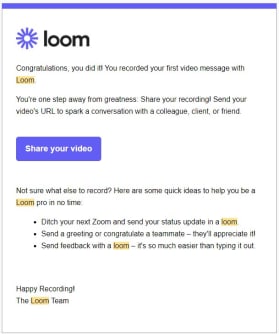
(Image source)
- Sending out interactive tutorials to guide new users through each step of your software, enhancing their understanding and improving their experience.
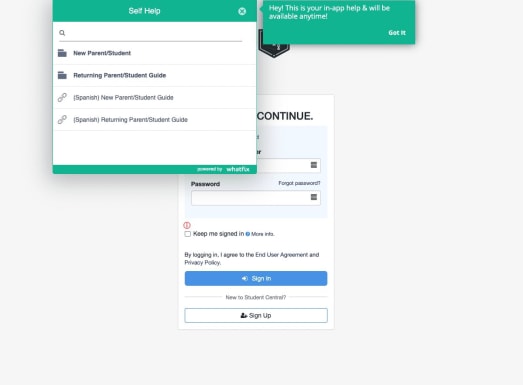
(Image source)
- Scheduling regular check-ins with customers to ensure they’re progressing and to address any onboarding issues they may encounter.
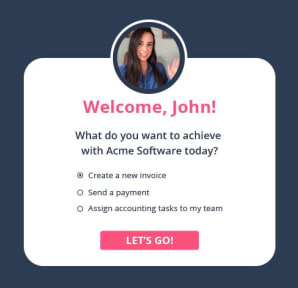
(Image source)
- Integrating with AI chatbots to resolve common customer queries will free up time for your team to focus on more complex issues.
3 company customer onboarding examples
These three companies excel at customer onboarding by quickly engaging users in their platforms.
1. Slack
Slack’s onboarding experience is user-friendly, beginning with a straightforward sign-up form and a welcome message. Interactive walk-throughs use empty states to introduce users to Slack channels and groups, while the built-in Slackbot and tooltips cover the basics to create an engaging journey.

(Image source)
2. Grammarly
Grammarly follows a learn-by-doing approach to onboard customers through the platform’s many features within a controlled environment. New users are introduced to personal writing functionalities like in-line suggestions for spelling, grammar, and word choice, while the interactive guide offers informative hotspots with additional explanations as users engage with them.
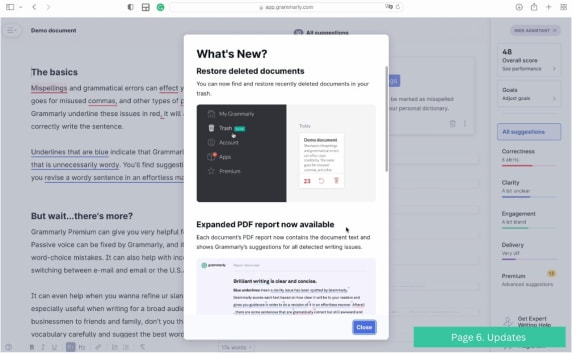
(Image source)
3. TikTok
From the outset, TikTok informs users that increased interaction with its social media platform, such as watching, liking, or commenting, will influence their content feed. The more that users swipe to receive content, the quicker the algorithm learns their preferences. As part of its customer education process, TikTok users quickly get to grips with how to receive relevant content, while the platform receives immediate engagement; it’s a win-win.
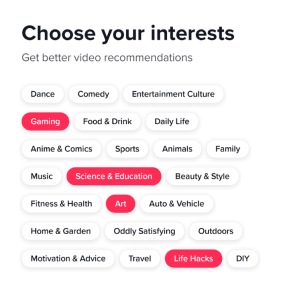
Onboard customers seamlessly with monday sales CRM
monday sales CRM is a highly customizable, no-code platform that allows you to build and manage tailored onboarding programs, and how they impact the entire customer lifecycle. Try the following features to gain an in-depth understanding of your customer’s journey:
- Customer onboarding dashboard: With 36+ drag-and-drop columns, you’ll gain granular visibility into your onboarding programs, track how long the process takes, and ensure that new users have access to all the information they need to become loyal customers.
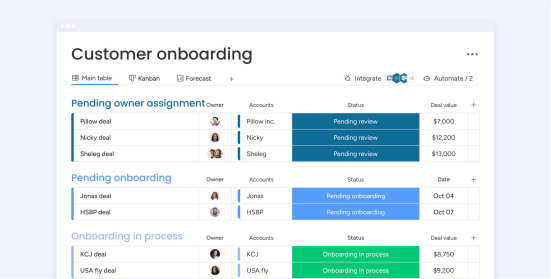
- Multiple views: Visualize your onboarding process in the way that makes the most sense to you. monday sales CRM offers 27+ views, including Kanban, Gantt, Table, Timeline, Map, and more. For example, you might use the Gantt View to check that your onboarding customers have completed their product demo by a certain milestone.
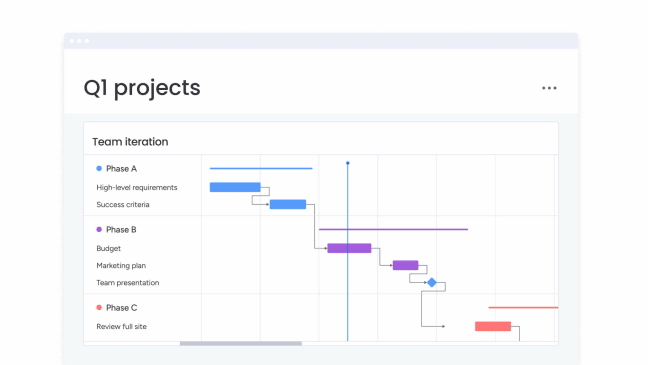
- Centralized communication: Keep your sales, marketing, customer service, and product teams aligned by syncing everyone on our collaborative platform. All stakeholders can view status updates and customer communications to understand common feedback or queries.
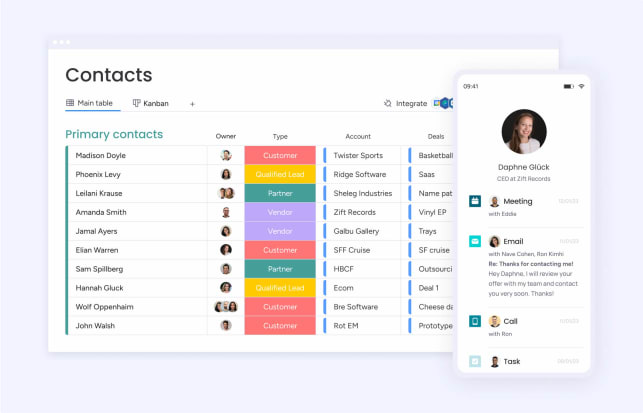
- Integrations: monday sales CRM integrates with 72+ apps so you can continue working with your preferred tools within our platform. For example, you can easily sync due dates with Google Calendar, add files from Dropbox, or exchange messages with your Customer Success team via Slack.
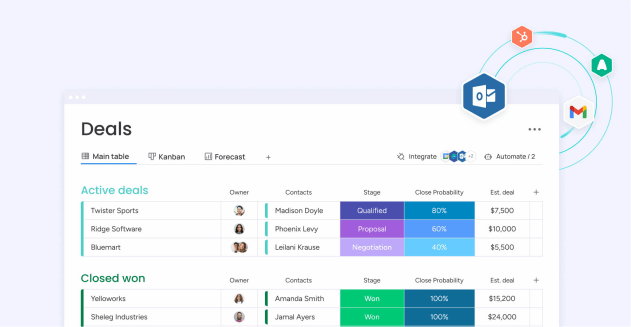
- Automations: Ensure new customers never have to wait for welcome messages or product guides by automating repetitive tasks. This also frees up time for your customer service or customer support teams to spend on more complex queries. You might set up an automated reminder message if your new customers don’t log in within X days or automatically notify your team when customers complete onboarding.
 Customer onboarding is a crucial phase in the overall customer lifecycle. Make a positive first impression during the handover from sales to customer support, and ensure your new users are set up to love your brand from day one. monday sales CRM will help you keep track of all the moving parts involved in onboarding customers, and measure the success of your strategy. Sign up for a trial today.
Customer onboarding is a crucial phase in the overall customer lifecycle. Make a positive first impression during the handover from sales to customer support, and ensure your new users are set up to love your brand from day one. monday sales CRM will help you keep track of all the moving parts involved in onboarding customers, and measure the success of your strategy. Sign up for a trial today.
FAQs
Does CRM software help with customer onboarding?
Yes, customer relationship management software can streamline the onboarding process and automate tedious tasks, allowing your team to focus on other areas. With monday sales CRM, you get access to a central dashboard where stakeholders can view customer data in real-time and coordinate onboarding efforts for maximum efficiency.
How can you improve customer onboarding?
If you're struggling with customer onboarding, take steps to personalize the experience to ensure it’s relevant to your new users. Sending out regular surveys and collecting customer behavior data provides you with insights into customer needs, helping you optimize their onboarding journey. Automating certain processes with a CRM platform will also improve efficiency.
How can you measure customer onboarding?
To understand if your onboarding program is successful, consider tracking metrics such as time to first value (TTFV), activation rate, rate of upgrade, customer engagement, completion rate, and customer churn rate. Always take a benchmark analysis of these customer onboarding metrics for comparison before and after changes to your program.


